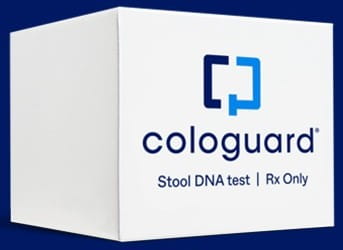COLOGUARD ADHERENCE
Observed adherence nearly doubles with the Cologuard® test1,2
Patient adherence rates for screening with the Cologuard test and colonoscopy were demonstrated in 2 separate studies1,2:
71%
Adherence
Over 1.5 million of ~2.1 million patients were adherent to the Cologuard test in a retrospective cohort study1
38%
Adherence
~900 of 2400 patients were adherent to screening colonoscopy according to a separate clinical study2
Average-risk patients preferred the Cologuard test over colonoscopy in a discrete choice experiment study.3*
optimize your experience
Which colorectal cancer (CRC) screening option do you prescribe most often to your average-risk patients?
Your most prescribed CRC screening option:
From 2018-2021, the Cologuard test contributed 77% to increases in CRC screening adherence.4†
Dr Timothy Quinn discusses the Cologuard impact on CRC screening rates in his practice
The Impact of the Cologuard Test on CRC Screening Adherence
Learn more with Dr Quinn and other providers.

Better outcomes with the Cologuard test
View the impact of a positive Cologuard result on follow-up colonoscopy adherence and quality.
After a positive Cologuard result, 79% of patients adhered to a follow-up colonoscopy.5‡
Cologuard adherence is supported by its patient navigation program6
Outreach through the patient navigation program resulted in an increase in adherence vs Cologuard patients who did not receive outreach.6 §

The Cologuard patient navigation program provides encouragement for patients throughout the screening process.
Belinda Khou has been compensated for sharing their expertise and for acting as a consultant for Exact Sciences.
- Individuals at average risk for CRC aged 45 to 75 (n=1249) preferred mt-sDNA (38.3%) over colonoscopy (32.5%; P<0.001).3
- Based on National Health Interview Survey data on CRC screening rates in 85,571 adults 50-75 years from 2005-2021. Starting in 2018, the survey began including mt-sDNA testing as a screening option. From then until the end of the study period, mt-sDNA testing had the largest increase in utilization and contributed the most to overall screening rates.4
- Continuous enrollment was required for ≥1 years after a positive stool-based test until the end of disenrollment, 3 months after a claim indicating high-risk criteria, or end of the study period.5
- Based on internal data from February 11, 2022, to September 5, 2022, that compared eligible patients who received outreach from the patient navigation program with a small control sample that did not in order to evaluate program effectiveness.6
CRC=colorectal cancer; mt-sDNA=multitarget stool DNA.
